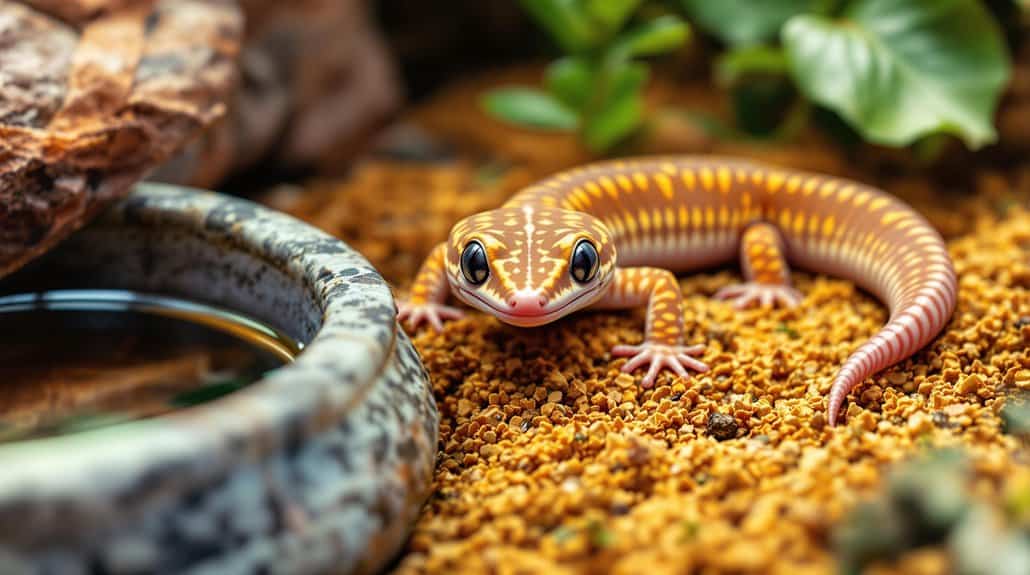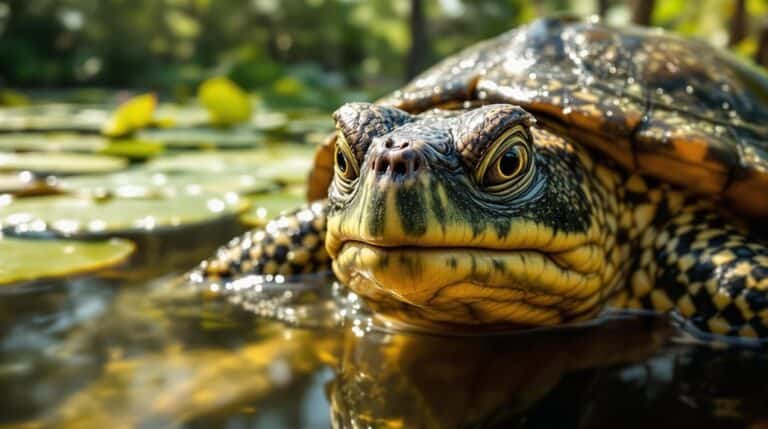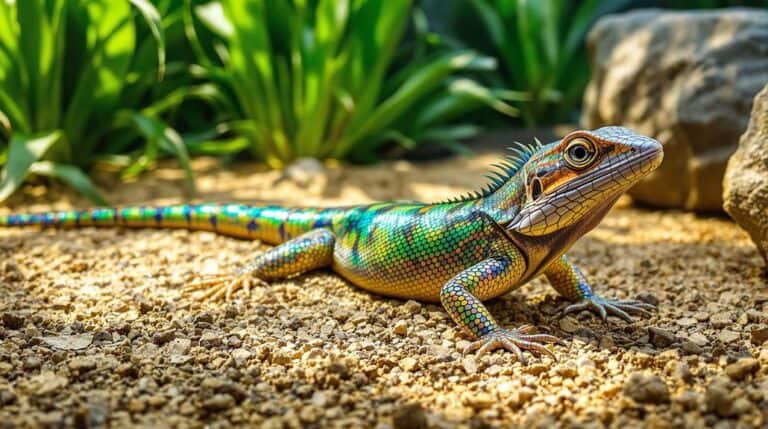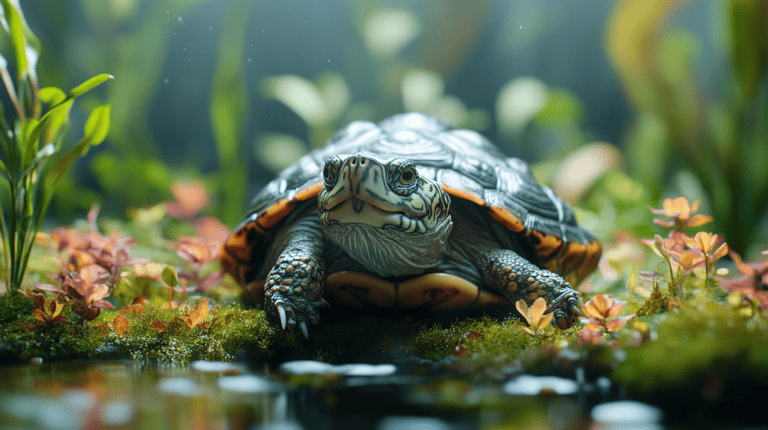African Fat Tailed Gecko Care
Caring for an African Fat-Tailed Gecko is like hosting a tiny reptilian rock star! You’ll want a cozy 20-gallon tank with hiding spots and lots of fun stuff for them to explore. Keep the temperature just right, warm like a sunny day at 90°F, and remember to spritz those humidity levels like you’re watering a plant! Feed them yummy, gut-loaded insects and sprinkle on some vitamins for extra pizzazz. Don’t forget to check their health often and handle them gently, like cradling a delicate treasure! Stick around, and I’ll share even more awesome tips to raise your gecko superstar!
Table of Contents
Key Takeaways
- Provide a minimum 20-gallon tank with a substrate of at least 4 inches for burrowing and safe materials like coconut fiber.
- Maintain a temperature gradient of 90-100°F in basking areas and 70-75°F in cooler zones, ensuring overall temperatures are between 22°C to 32°C.
- Feed a diet of gut-loaded insects, like crickets and mealworms, every 4-5 days for adults, dusted with calcium and multivitamins.
- Keep humidity levels at 50-60% during the day and 70-80% at night, and ensure fresh water is available daily.
- Regularly clean the enclosure to prevent health issues and monitor your gecko for signs of illness or stress.
Housing and Environment
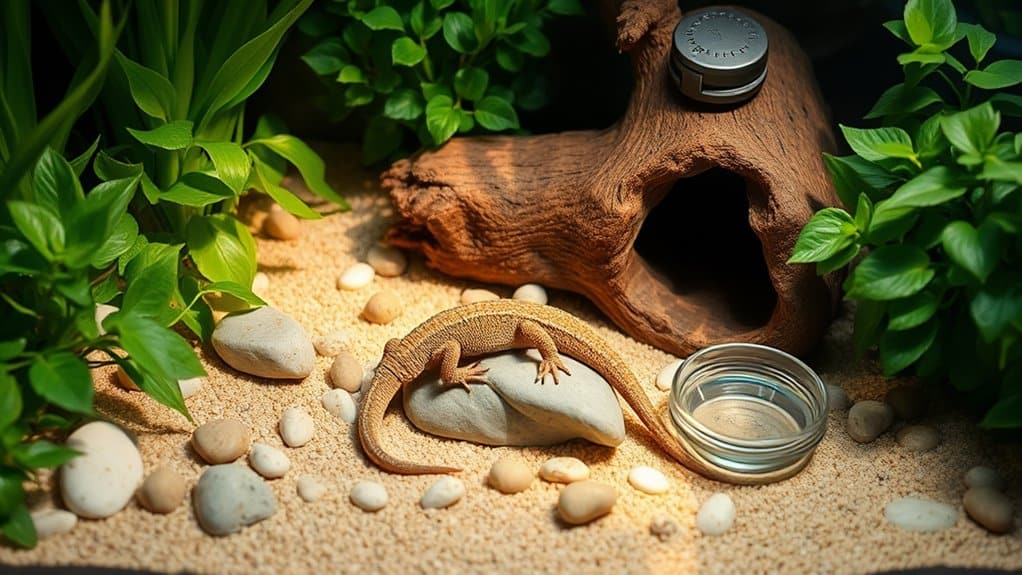
Creating the perfect housing and environment for your African Fat Tailed Gecko is essential for its health and well-being. Think of their enclosure as a cozy, mini jungle! For adults, you’ll want a space of at least 3 x 2 x 2 feet, or a 20-gallon tank. That’s like giving them a penthouse! Don’t forget the substrate depth—at least 4 inches. This lets them burrow, which they absolutely love!
Now, let’s talk temperature. You need a temperature gradient between 22°C and 32°C, with a warm basking spot of 90-100°F. Imagine the luxury! And lighting? Keep it on for 12 hours a day, adjusting a bit for the seasons. No UVB bulb needed if their diet includes sufficient D3, which helps maintain their health. Additionally, it’s important to ensure that you provide a minimum of two hiding places for their security.
Humidity levels are key! Aim for 50-60% during the day and 70-80% at night. You can use moist hiding spots with sphagnum moss for added comfort.
Lastly, enrich their world! Add branches, rocks, and tunnels for exploration. It’s like an adventure park for your gecko! Rotate the decor to keep things fresh and exciting. Your gecko will thank you with all the wiggles and wags! Don’t forget to include climbing opportunities, as these little creatures love to explore vertically. A carefully thought-out crested gecko terrarium setup with varying textures and hiding spots will help mimic their natural environment and keep them happy. By providing enrichment and variety, you’ll create a habitat that promotes both their mental and physical well-being.
Diet and Nutrition
A healthy diet is just as important as a well-designed habitat for your African Fat Tailed Gecko. Think of it like fueling a tiny rocket! You want a mix of insect variety to keep them zipping around happily. Crickets, mealworms, locusts, and even cockroaches make the perfect menu. For young geckos, I feed them daily, offering 2-3 bugs for every inch of their length. For the older crowd, it’s every 4-5 days with 8-9 crickets or mealworms.
Don’t forget to dust those little critters with calcium and multivitamins—it’s like giving them a superhero cape! And remember, insects shouldn’t be bigger than 3/4 of your gecko’s head. Additionally, ensure that the insects are nutritionally enriched before feeding to provide the best possible nutrition. It’s also essential to maintain optimal humidity levels of 70-80% during daytime to support their hydration needs.
Hydration is key too! A shallow dish of fresh water should always be available. If they leave uneaten food, take it out after a few hours.
Watching them munch away is such a joy! I feel like a proud chef, serving up tasty treats. By mixing up their diet and sticking to a feeding frequency, we guarantee our geckos stay healthy and vibrant. Let’s keep those tails fat and spirits high!
Hygiene and Cleaning
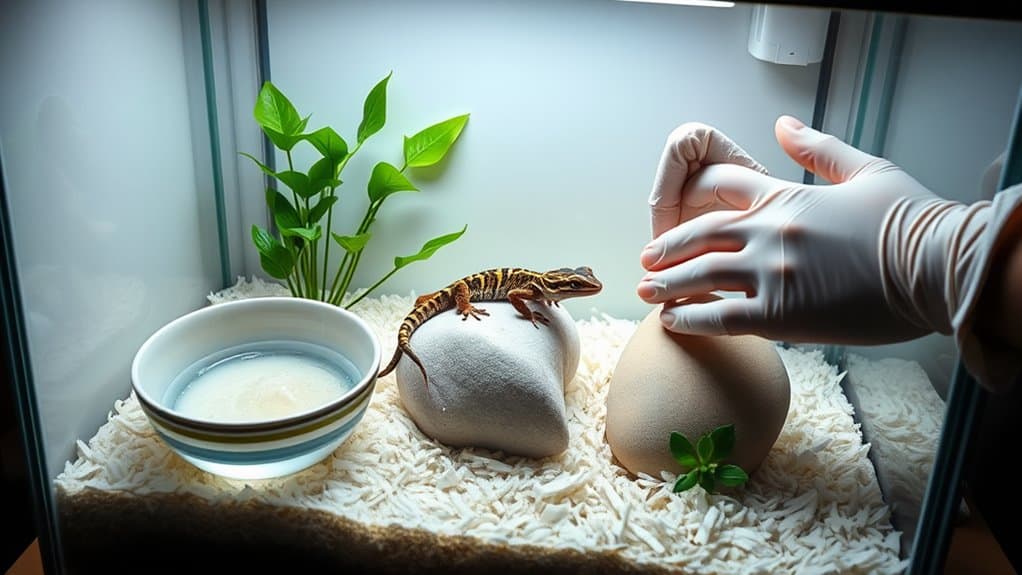
Maintaining a clean environment for your African Fat Tailed Gecko is essential for their health and well-being. Think of it like giving your gecko a cozy, safe home where they can thrive! A regular cleaning schedule will keep things fresh and fun. Here’s how I do it:
- Daily: I check for any poop or uneaten food, clean their water and food dishes, and keep an eye on humidity and temperature. Oh, and pest prevention is key—always inspect for those little critters!
- Weekly: I change the substrate and give surfaces a good scrub with a reptile-safe cleaner. I rearrange decorations to spark curiosity and make sure there’s no mold lurking in humid spots. It’s important to remember that maintaining proper humidity levels is crucial for their overall health. Additionally, keeping adequate hiding spots helps reduce stress in your gecko.
- Monthly: It’s deep clean time! I remove everything, disinfect the enclosure, and replace anything worn out. Plus, I give my gecko a health check and adjust their home as needed.
Handling and Socialization
When you bring home an African Fat Tailed Gecko, understanding how to handle and socialize with them is essential for building trust and ensuring their comfort. It’s like making a new friend—you’ve got to earn their trust!
Here’s a quick guide to handling techniques and socialization strategies:
| Handling Techniques | Socialization Tips |
|---|---|
| Wait 2 weeks before handling. | Start with short 5-minute sessions. |
| Support their body fully. | Handle them in the evening. |
| Introduce your hand gently. | Use soft surfaces to catch them. |
| Avoid grabbing or chasing them. | Be consistent with your handling. |
Always remember, our gecko friends prefer calm environments, so keep it chill! Use positive reinforcement, like a tasty bug, to make handling fun. And hey, never hold their tail; it’s like grabbing someone’s hair—ouch! Additionally, regular handling helps increase comfort and allows them to acclimate to their new surroundings. It’s important to note that regular handling is key for acclimation, especially for young geckos.
Health and Common Issues
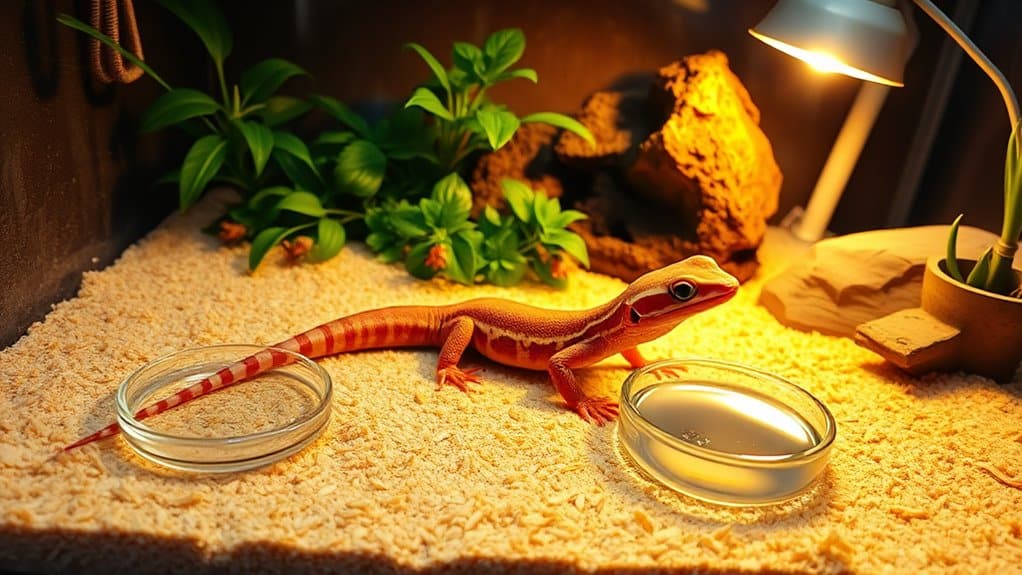
Ensuring your African Fat Tailed Gecko stays healthy is essential for its well-being and longevity. Just like us, our little buddies can face health hiccups! That’s why health monitoring and disease prevention are super important. Here’s what to keep an eye out for:
- Metabolic Bone Disease: If you see rubbery bones, it’s a sign of calcium or Vitamin D3 deficiency!
- Parasites: Smelly poop or weight loss? Time to call the vet!
- Impaction: Improper temps and dehydration can lead to a bloated belly. Yikes!
To keep your gecko thriving, I recommend regular cleaning of their home, providing UVB light for calcium absorption, and feeding them a nutrient-rich diet. It’s like giving them a superhero diet! Don’t forget to keep the temperature and humidity just right—it’s their cozy climate! Additionally, maintaining a temperature gradient in their enclosure helps prevent health issues related to improper heat levels. Regular observation and documentation of changes in health are essential for early detection of any issues that may arise.
Also, remember to quarantine any new geckos for a month to avoid sneaky diseases. If you notice anything off, consult a vet pronto! A happy gecko is a healthy gecko, and I can’t wait for you both to enjoy a long, joyful adventure together!
Lifespan and Upkeep Costs
A healthy African Fat Tailed Gecko can live a long and fulfilling life, with proper care allowing them to reach up to 20 years in captivity. Isn’t that amazing? Think about it! That’s like having a tiny, scaly roommate who’ll stick around for two decades! But remember, lifespan variability is real. Factors like diet, housing, and health play a huge role in how long they thrive. If you give them the right food and comfy home, they’ll be happy little critters! Additionally, maintaining the right temperature and humidity in their habitat is crucial for their overall health and skin shedding.
Now, let’s talk about the cost analysis. Setting up your gecko’s habitat can be a bit pricey at first. You’ll need a decent enclosure, heating, and lighting. But don’t worry! Once you get that sorted, ongoing costs aren’t too bad. Most of your expenses will come from food, like crickets and mealworms. If you’re feeling adventurous, you can even grow some food at home to save money!
Additional Tips for Care
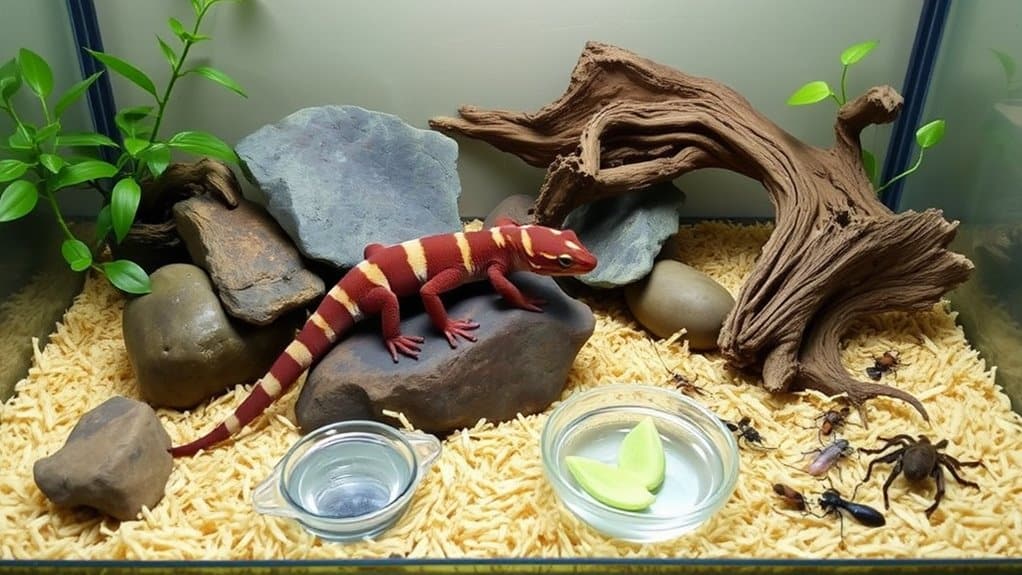
Although it may seem straightforward, caring for an African Fat Tailed Gecko involves several important considerations to keep them healthy and happy. These little guys are not just cute; they need a comfy home and a little fun! Here are some extra tips you’ll love:
- Enclosure Size: Make sure your gecko has a spacious home—at least 3 x 2 x 2 feet! They love to roam and burrow. Remember, minimum 20-gallon terrarium is essential for adults.
- Temperature Control: Create a cozy temperature gradient. They need a warm basking spot (90-100°F) and a cooler area (70-75°F) to chill out. It’s like their personal spa day!
- Behavioral Enrichment: Spice things up by adding plants, rocks, and logs. This encourages natural behaviors, making them feel more alive. Plus, if you’re into breeding techniques, a stimulating environment can help!
Don’t forget to feed them a variety of gut-loaded insects! It’s like serving a gourmet meal. With these tips, you’ll be on your way to a thriving, happy African Fat Tailed Gecko. Remember, a little effort goes a long way in creating a joyful space for your scaly friend!
Conclusion
So, there you have it! Caring for an African fat-tailed gecko is like being a superhero for a tiny creature! With the right home, yummy food, and lots of love, you’ll have a happy little buddy. Remember, they might not wear capes, but they sure can wiggle! Just keep an eye on their health, and you’ll have a friend for years to come. Now, go on and be the best gecko parent ever! 🦎❤️

